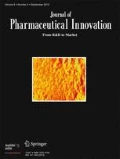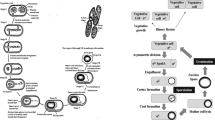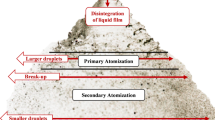Abstract
The study presented here examined the factors influencing the effectiveness of surface decontamination with hydrogen peroxide vapor. The impact of relative humidity and hydrogen peroxide gas concentrations was investigated and compared to a dew point analysis of these various sterilant atmospheres. For this purpose, a series of different H2O2 decontamination cycles were developed and tested for antimicrobial effectiveness using biological indicators inoculated with greater than 106 spores of Geobacillus stearothermophilus. The results indicate that an increasing concentration of hydrogen peroxide in the gas phase and higher humidity levels result in a faster inactivation of the test organisms. The higher the H2O2 gas phase concentration was, the more independent the inactivation effect from the humidity level. At lower H2O2 concentrations, the same kill was achieved with higher humidity. Subvisible condensation was found to be necessary for short inactivation times, but condensation in the visible range did not further enhance the sporicidal activity. The molecular deposition of water and hydrogen peroxide on the target surface represents the determining factor for microbial inactivation, whereas the hydrogen peroxide concentration in the gas phase is of secondary importance.














Similar content being viewed by others
References
McDonnell G, Russell D. Antiseptics and disinfectants: activity, action and resistance. Clin Microbiol Rev 1999;12(1):147–79.
Heckert RA, et al. Efficacy of vaporized hydrogen peroxide against exotic animal viruses. Appl Environ Microbiol 1997;63(10):3916–8.
Kokubo M, Inoue T, Akers J. Resistance of common environmental spores of the genus bacillus to vapor hydrogen peroxide. PDA J Pharm Sci Technol 1998;52(5):228–31.
Klapes NA, Vesley D. Vapor-phase hydrogen peroxide as a surface decontaminant and sterilant. Appl Environ Microbiol 1990;56(2):503–6.
Graham GS, Rickloff JR, Dalmasso JP. Sterilization of isolators and lyophilizers with hydrogen peroxide in the vapour phase. In: Proceedings of the International Congress of the Parenteral Drug Association, 1992, Basel, Switzerland, p. 32–51.
US EPA. Compilation of available data on building decontamination alternatives. EPA Work Assignment (WA) 1–31. Reston, VA: US Environmental Protection Agency, Science Applications International; 2005.
Khorzad D, et al. Vapor-phase hydrogen peroxide Biological Indicator Evaluator Resistometer (BIER) unit. Pharm Technol 2003;27(11):84–90.
Lysfjord J, Porter M. Barrier isolation history and trends, a millennium update. Pharm Eng 2001;21(2):142–5.
Gail L, Sirch E. Development of isolator technology. In: Reinraumtechnik. 2nd ed. H.-P. Hortig: Berlin, Germany; 2004. p. 174.
US Pharmacopoeia. General information. Biological indicators for sterilization (Chapter 1035). In: US Pharmacopoeia (USP) 27, United States Pharmacopoeial; 2003, p. 2413–2416.
Unger B, et al. Suitability of different construction materials for use in aseptic processing environments decontaminated with gaseous hydrogen peroxide. PDA J Pharm Sci Technol 2007;61(4):255–75.
Sigwarth V, Stärk A. Effect of carrier materials on the resistance of spores of bacillus stearothermophilus to gaseous hydrogen peroxide. PDA J Pharm Sci Technol 2003;57(1):3–11.
Steris. Vapor phase hydrogen peroxide cycle development guide. Mentor, OH: Steris; 2001.
Hultman C, Hill A, McDonnell G. The physical chemistry of decontamination with gaseous hydrogen peroxide. Pharm Eng 2007;27(1):22–32.
Imai K, et al. A new approach to vapor hydrogen peroxide decontamination of isolators and cleanrooms. Pharm Eng 2006;26(3):96–104.
Watling D, et al. Theoretical analysis of the condensation of hydrogen peroxide gas and water vapour as used in surface decontamination. PDA J Pharm Sci Technol 2002;56(6):291–9.
Marcos-Martin MA, et al. Sterilization by vapour condensation. Pharm Technol Eur 1996;18(2):24–32.
Watling D. Theory and practice of hydrogen peroxide vapour. Online on the internet: URL: http://www.pharmaceutical-int.com/categories/biodecontamination-using-hydrogen-peroxide-vapour/theory-and-practice-of-hydrogen-peroxide-vapour.asp (status 18.02.2008); 2002
Brown GP, et al. Calibration of a near-infrared (NIR) H2O2 vapor monitor. Pharm Eng 1998;18(6):66–76.
United States Pharmacopoeia. General information, biological indicators—resistance performance tests (Chapter 55). In: United States Pharmacopoeia (USP) 28, United States Pharmacopoeial; 2005, p. 2244.
FDA. FDA guidance for industry: sterile drug products produced by aseptic processing-current good manufacturing practice. Washington, DC: FDA; 2004.
International Organization for Standardization/Draft International Standard. ISO/DIS 11138-1: draft: sterilization of health care products-biological indicator systems—part 1: general requirements. Geneva: International Organization for Standardization; 2004.
European Pharmacopoeia. Biological indicators for inspection of sterilization methods (Chapter 5.1.2). In: European Pharmacopoeia, 3rd ed. Stuttgart: Deutscher Apotheker Verlag Stuttgart; 1997. p. 381–382.
Cochran WG. Estimation of bacterial densities by means of the most probable number. Biometrics 1950;6(2):105–116.
Alexander M. Most probable number method for microbial populations. In Page AL et al., editors. Methods of soil analysis. Part 2. 2nd ed. Agronomy 9; 1982. pp. 815–820.
Sun X, Kurosu S, Shintani H. The expanded application of most probable number to the quantitative evaluation of extremely low microbial count. PDA J Pharm Sci Technol 2006;60(2):124–34.
McCrady MH. The numerical interpretation of fermentation tube results. J Infect Dis 1915;17:183–212.
Blodgett R. Most probable number from serial dilutions. Bacterial analytical manual online. US Food and Drug Administration. Online on the internet: URL: http://www.cfsan.fda.gov/~ebam/bam-a2.html (status 18.02.2008). 2006.
Haas CN. Estimation of microbial densities from dilution count experiments. Appl Environ Microbiol 1989;558:1934–42.
Acknowledgment
We acknowledge Benjamin Stelzner for his assistance with the preparation and execution of the experiments.
Author information
Authors and Affiliations
Corresponding author
Rights and permissions
About this article
Cite this article
Unger-Bimczok, B., Kottke, V., Hertel, C. et al. The Influence of Humidity, Hydrogen Peroxide Concentration, and Condensation on the Inactivation of Geobacillus stearothermophilus Spores with Hydrogen Peroxide Vapor. J Pharm Innov 3, 123–133 (2008). https://doi.org/10.1007/s12247-008-9027-1
Published:
Issue Date:
DOI: https://doi.org/10.1007/s12247-008-9027-1




